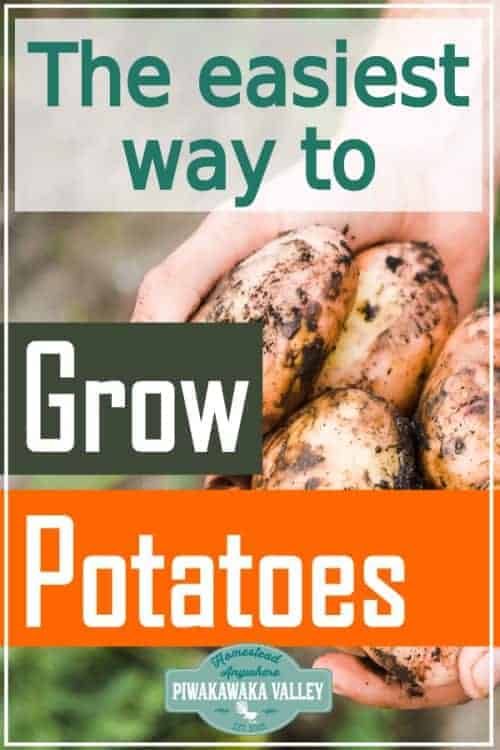This post was most recently updated on July 21st, 2020
Growing the best potatoes is very easy with a little preparation. Growing potatoes in mulch, using a no dig gardening method is the best and easiest way to get nice and big and easy to harvest potatoes from your garden. Below we will look at Back to Eden potatoes in your garden.
Please read: This information is provided for educational purposes only and is not intended to treat, diagnose or prevent any disease. We encourage you to make your own health care decisions in partnership with a qualified health care professional.
This post contains affiliate links, this means at no extra cost to you, we make a commission from sales. Please read our Disclosure Statement
What is Back to Eden Gardening?
The back to Eden gardening method is an idea thought up by Paul Gautschi, and it just makes so much biological sense.
Using nature’s own methods, we can quickly rebuild topsoil, grow healthy plants and support all the natural bugs and insects as well as the microbiota that keep our soil healthy and alive.
To grow a BTE garden you need lots and lots of wood mulch, and in many places you can get this for free from your local council, or you can buy it for very cheap from arborists.
Read all about setting up your back to Eden garden here.
Growing Potatoes Under Mulch with the Back to Eden Method
Usually with BTE gardening, you have to pull the mulch right back and ensure you are planting in to the soil, as plants won’t grow in mulch.
However, with potatoes, this is a rare time that you can change that!
Prepare your potatoes for planting
Sit your seed potatoes (either from last season in your garden, or from the local nursery) in a tray lined with news paper in a cool dark place for a few weeks and allow them to sprout.
You can plant your potatoes whole if you like, or you can cut them in to at least 1 inch pieces, with each piece having 1-2 eyes on it – these are the bits that sprout.
If you decide to cut your potatoes before planting them, allow them to sit for another day or two for the wounds to dry up. This reduces the chance of them getting a fungal infection and rotting rather than growing.
Prepare your garden for the potatoes
In the Back to Eden method of growing potatoes, this takes very little effort. Simply pull the mulch back in rows where you want to grow your potatoes, and add a little compost to the bottom of the trench.
RELATED: Free Gardening Resources
Sowing potatoes in your Back to Eden Garden
Put your seed potatoes in to your garden with the eyes pointing up, sitting on top of the compost.
Cover the potatoes with all the mulch that you pulled back, and top it up to 6 inches deep.
Once the greens are poking through, you can add a further 2-6 inches of mulch.
Harvesting potatoes from your BTE garden
Once your potato plant has flowered, you can harvest new potatoes to use in the next day or two.
If you want to store your potatoes for later, it is best to wait until your plant begins to die back before harvesting, this allows the potatoes to mature and makes better storage spuds.
To harvest your potatoes while the plant is still attached, grasp the bottom of the stem firmly and slowly wiggle it side to side while pulling upwards, the stem should come up with all the potatoes still attached.
To check for stragglers, just reach in the mulch and feel around. There is no need for digging and forking with growing potatoes this way.
If you really want to take it to the next level, find your biggest potatoes and re-space them, and leave them in the ground for the next crop. You can pretty much just keep doing this cycle with the Back to Eden method as your soil is so healthy.
If you are new to gardening, or want some support and knowledge getting a garden started, I would love to help you.
Storing Potatoes
If you are planning on eating the new potatoes in the next week, store them as is in a cardboard pox somewhere cool and dark.
For long term storage of potatoes, wipe/dust the worst of the dirt and debris off of them, and look through them carefully. Remove any that look damaged, soft or otherwise suspicious and eat them first (or cook them for the chickens).
Leave the potatoes out in a single layer on the countertop or similar until the outside is dry to the touch – 2-3 hours, turning to ensure all sides are dry.
Place the potatoes in clean and dry thick paper sack. You can save them from bought potatoes, use garbage sacks made of paper, or create your own by taping or stapling together several layers of newspaper.
Store the potatoes somewhere cool, dry and dark.
Check over them every 7-10 days for signs of deterioration. Remove any that are looking soft or mouldy as this can affect the whole bag. Be gentle when you handle them, as bruises will become diseased later.
Another way to grow potatoes is in tire stacks or pots.
If you would like help getting the most out of your garden, I would love to help you, find out more here
RELATED: Free Gardening Resources
If you like tips on frugal living, self sufficiency and consuming less, sign up to our newsletter below, I would LOVE to have you
For further reading, I also recommend all of these books. I own every one of them and they are amazing resources!






























